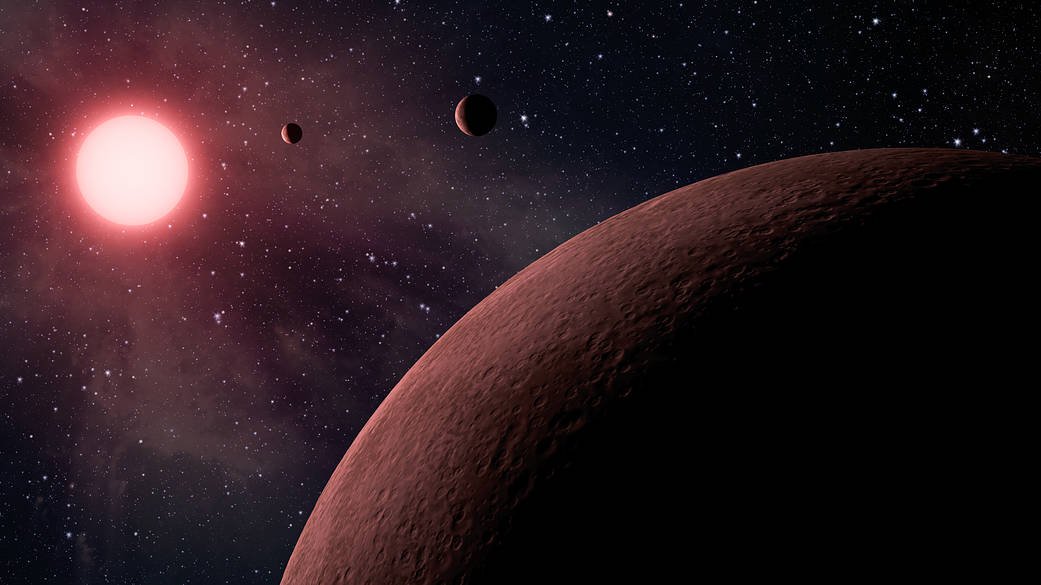A new analysis by researchers from the University of Florida revealed that there may be hundreds of millions of habitable planets in the Milky Way Galaxy orbiting M-dwarf stars.
Compromising about 73% of the estimated 100 – 400 billion stars in the Milky Way, M-dwarfs have become the favored place for astronomers to search for rocky, earthlike planets due to the fact that they are more plentiful than G-type stars like our sun and because It is easier to spot exoplanets in their orbits with current telescopes due to the fact that M-dwarfs are not as bright as other stars.
M-Dwarfs are the Perfect Place to Look for Habitable Planets
“M dwarf stars are emerging as the predominant target to search for exoplanets for a few reasons,” explained researcher and Ph.D. candidate Sheila Sagear in an email to The Debrief, who, along with U of F professor Sarah Ballard conducted the research.
“They are by far the most common stars, with around 75% of stars in the Milky Way being M dwarfs, they are more likely to host small, rocky, roughly Earth-sized planets (as opposed to gas giants such as Jupiter and Saturn) than larger stars like our Sun, and it is typically easier to detect and characterize planets around smaller stars such as M dwarfs than larger stars like our Sun,” Sagear added.
Although a number of conditions determine habitability, Sagear and Ballard focused their attention on the eccentricity of the orbits of planets around M-dwarf stars.
“For M dwarf stars, orbital eccentricity is particularly important because these stars are much cooler than stars like our Sun, so the “habitable zone” (the star-planet distance that would make it possible to sustain liquid water) is quite narrow,” Sagear told The Debrief. “Even a modest orbital eccentricity could cause a planet to swing into and out of the habitable zone during its orbit, rendering it too hot or cold to sustain life most of the time.”
Interestingly, Sagear explained that the opposite is true as well. A planet that initially appears too far away to get enough to heat from its host star to achieve habitability may actually benefit from an eccentric orbit that could bring that planet closer to its host star during part of the year to sustain a habitable temperature.
Research Determines that Approximately 1 in 3 Planets May Have Orbits Supporting Habitability
Published in the Proceedings of the National Academy of Sciences, the work by Sagear and Ballard focused on over 150 M-dwarf stars between 130 to 2000 light-years away from Earth. This work used what is known as the transit method, where the light from the host star dims as the planet passes between it and our telescopes, allowing researchers to learn all kinds of information about the planet.
Following careful analysis, the duo found that about one out of every three exoplanets orbiting M-dwarf stars has an orbit that is favorable to habitability. This astonishing number means there are potentially billions of planets that can support life in our Milky Way galaxy alone.
“We found that several multi-planet systems are likely to have near-circular orbits, and some planets in these systems could potentially lie in the habitable zone,” Sagear told The Debrief.
“This doesn’t mean that the planets aren’t tidally locked (where the same side of the planet always faces the star, just like the Moon does with the Earth, and tidal locking is not good for the prospects of habitability,” Sagear added. “This also doesn’t mean that other conditions are conducive to habitability (such as the planet’s composition and atmosphere), but this is a good sign for habitability.”
Follow Up Research Could Help Determine Other Conditions Affecting Habitability
Sagear told The Debrief that they didn’t fully assess the habitability of each planet. Instead, they found that the closest planets in their sample that orbit in the habitable zone and are likely to have near-circular orbits are Kepler-296 f, around 545 light-years from Earth, and Kepler-186f, around 580 light-years from Earth.
Of course, the research team fully concedes that many things besides orbit will ultimately determine whether a planet is truly habitable. This includes the composition of the planet itself.
“The composition of a planet does strongly affect the rate of tidal heating, as does the geometry of its orbit,” Sagear told The Debrief. “However, the composition of most of the planets in our sample is not well understood.”
The researchers note that follow-up observations could help to characterize the makeup and orbits of their target planets to further refine their tantalizing results, including things like composition.
“We may not be able to say for certain that a specific planet is or is not habitable — we will need more follow-up studies to confirm this,” Sagear told The Debrief. “However, with the results of this work, we can assess the probability that a population of nearby M dwarf planets has circular or eccentric orbits. This information will help us decide which (and how many) planets to target for more precise follow-up observations in the future.”
Although there is no specific timeline for these follow-up observations, Sagear notes that a range of actors will ultimately determine if an exoplanet orbiting an M-dwarf star is truly capable of supporting life as we know it.
“These follow-up observations will help us characterize their compositions and atmospheres, picture what the planet’s surface may be like during different seasons, and decide with more certainty whether a particular planet is habitable or not,” she concluded.
Christopher Plain is a Science Fiction and Fantasy novelist and Head Science Writer at The Debrief. Follow and connect with him on Twitter, learn about his books at plainfiction.com, or email him directly at christopher@thedebrief.org.

